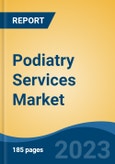Speak directly to the analyst to clarify any post sales queries you may have.
10% Free customizationThis report comes with 10% free customization, enabling you to add data that meets your specific business needs.
According to the Centers for Disease Control and Prevention, in 2021, 38.4 million people in the U.S., or 11.6% of the population, were living with diabetes. Among adults aged 18 and older, 38.1 million individuals, or 14.7% of the adult population, had diabetes. Additionally, 8.7 million adults aged 18 or older met the laboratory criteria for diabetes but were either unaware or did not report the condition, representing 3.4% of all U.S. adults and 22.8% of all adults with diabetes.
The growing recognition of the importance of foot health, particularly in managing chronic conditions and preventing complications, is further fueling market growth. Advancements in podiatric treatments, such as minimally invasive procedures and improved prosthetics, are also contributing to market expansion. The increasing availability of podiatry services in both clinical and home settings, along with the rise of telemedicine, is driving the market forward.
Key Market Drivers
Rising Prevalence of Foot and Ankle Disorders
The growing incidence of foot and ankle disorders is a significant factor contributing to the expansion of the Global Podiatry Services Market. Conditions such as diabetic foot ulcers, arthritis, plantar fasciitis, bunions, and Achilles tendinopathy are becoming increasingly common worldwide, with diabetic neuropathy and vascular diseases playing a major role in driving demand for specialized podiatric care. As diabetes rates rise, foot complications like neuropathy and poor circulation are becoming more frequent. Diabetic foot ulcers, for example, are a leading cause of hospitalizations and amputations, resulting in a heightened demand for both preventive and therapeutic podiatric services.Key Market Challenges
High Cost of Specialized Podiatric Care
A significant challenge facing the podiatry services market is the high cost of specialized care, which includes diagnostic tests, treatments, and custom orthotics. Procedures such as surgeries for foot deformities and the provision of custom orthotics can be expensive, especially in regions without universal healthcare. Even in developed countries, co-pays for podiatric services may still impose a financial burden on patients, particularly those requiring long-term treatment. For individuals with chronic conditions like diabetes or arthritis, the ongoing costs of podiatric visits and specialized footwear can accumulate rapidly. In lower-income regions, the affordability of such services is a major barrier, preventing individuals from seeking necessary care until conditions become severe. These high costs may restrict access to care for a substantial portion of the population, thereby slowing market growth.Key Market Trends
Advancements in Medical Technology and Podiatric Treatments
Advancements in medical technology and podiatric treatments are significantly influencing the growth of the Global Podiatry Services Market. Innovations such as laser therapy, shockwave therapy, 3D imaging, and robotic-assisted surgeries have revolutionized the podiatric field. These technologies allow podiatrists to treat foot and ankle conditions with greater precision, reducing recovery times and improving patient outcomes. For instance, laser therapy offers a non-invasive treatment option for conditions like plantar fasciitis and Achilles tendinopathy, providing patients with effective and less painful alternatives to traditional methods such as injections or surgery. The Royal College of Podiatry (RCPod) has published a report analyzing a decade's worth of podiatric care data, offering valuable insights into national trends, including injury rates, procedures, and patient outcomes.Key Market Players
- CuraPodiatrics Pvt Ltd
- Premier Podiatry Services, Ltd
- The London Podiatry Centre Ltd
- Podiatry Inc.
- Podiatry Plan Inc.
- Ankle & Foot Centers of America
- Preferred Podiatry Group, P.C.
- New York Foot Care Services, PLLC
- Home Foot Care, Inc.
- Surrey Foot Service Ltd.
Report Scope
This report segments the Global Podiatry Services Market as follows:
By Treatment Condition:
- Cardiovascular Diseases
- Diabetes
- Musculoskeletal Diseases
- Neurological Diseases
- Non-Comorbid Conditions
By Service:
- General Podiatry
- Podiatry Surgery
- Podopediatrics
- Sports Podiatry
By Application:
- Home Care & Telemedicine
- Hospitals & Outpatient Departments
- Podiatry Office & Clinics
By Region:
- North America (U.S., Canada, Mexico)
- Europe (France, United Kingdom, Italy, Germany, Spain)
- Asia-Pacific (China, India, Japan, Australia, South Korea)
- South America (Brazil, Argentina, Colombia)
- Middle East & Africa (South Africa, Saudi Arabia, UAE)
Competitive Landscape
The report provides detailed company profiles of the key players in the Global Podiatry Services Market.Available Customizations
TechSci Research offers customizations for the Global Podiatry Services Market report to meet specific company needs, including:
- Detailed analysis and profiling of additional market players (up to five).
This product will be delivered within 1-3 business days.
Table of Contents
Companies Mentioned
- CuraPodiatrics Pvt Ltd
- Premier Podiatry Services, Ltd
- The London Podiatry Centre Ltd
- Podiatry Inc.
- Podiatry Plan Inc.
- Ankle & Foot Centers of America
- Preferred Podiatry Group, P.C.
- New York Foot Care Services, PLLC
- Home Foot Care, Inc.
- Surrey Foot Service Ltd.
Table Information
| Report Attribute | Details |
|---|---|
| No. of Pages | 182 |
| Published | February 2025 |
| Forecast Period | 2024 - 2030 |
| Estimated Market Value ( USD | $ 4.67 Billion |
| Forecasted Market Value ( USD | $ 5.73 Billion |
| Compound Annual Growth Rate | 3.4% |
| Regions Covered | Global |
| No. of Companies Mentioned | 10 |









